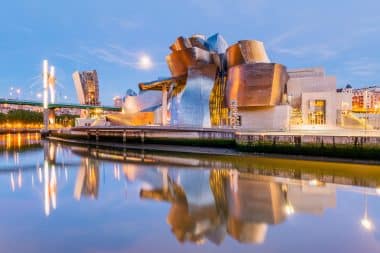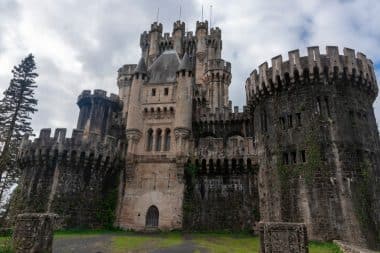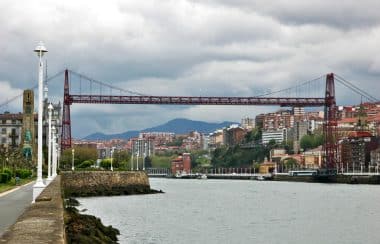Bilbao is the largest city in the Basque Country and is located in the north of Spain. At the same time, it is the capital of the Spanish province of Biscay. Like Catalonia, the Basque Country has its own culture and language that coexists alongside Spanish culture. Bilbao is also one of the most beautiful cities in the Iberian Peninsula. In addition to the numerous industrial complexes, the city is also characterized by a variety of entertainment facilities.
Peculiarities of the Basque city
Bilbao is a great place to visit at any time of the year. However, the Basque metropolis is at its most beautiful from March to September. In the summer months, a stay in Bilbao is considered quite pleasant. For example, the city is located in the north, which means that it is less hot there than in Madrid, for example. In winter, on the other hand, abundant precipitation can fall.
Mobility in the city is ensured by a densely developed network of trams and subways. Of course, there are also numerous accommodation options such as hotels in the city. In recent years, there has been a steady increase in visitors to Bilbao. The city is particularly appreciated for its art and culture as well as for its culinary delights.
The sights of Bilbao
Of course, Bilbao has many interesting sights to offer its guests. In addition to imposing buildings, this also includes numerous museums on a wide variety of topics.
A visit to the Guggenheim Museum

Meanwhile, one of Bilbao’s biggest landmarks is the Guggenheim Museum. It stands out for its striking exterior and represents the municipal museum of modern and contemporary art. Its opening took place in 1997. The Guggenheim Museum has left a lasting mark on Bilbao. There is even talk of a Guggenheim effect. More and more visitors flocked to the Basque city to visit the museum, which in turn had a positive effect on the economy of the metropolis.
The entire district around the Guggenheim Museum has been redesigned. For example, sporting events are held there more frequently. The exterior of the museum, which is made of glass, limestone and titanium, is also particularly worth seeing. The building on the banks of the Nervion River looks like a huge ship.
Stroll through Bilbao’s old town
The old town of Bilbao (Casco Viejo) presents itself beautifully. It is concentrated on seven streets that date back to the 15th century. In the small streets, textile and retail shops await the visitor. In addition, imposing churches and historic buildings can be admired. There is a cathedral, the Historical Museum and the Basque Archaeological Museum.
Among the tips of the old town are the Pinxto pubs, which invite you to take a detour. On Sundays, you can also browse the flea market.
Visit to the San Mamés Barria football stadium
Football fans will be in for a treat at Athletic Bilbao’s modern Estadio San Mamés Barria . It was built right next to the old Sam Mamés from 1913. The atmospheric stadium is affectionately called “La Catedral” by fans. When the local fans perform traditional songs, a very special atmosphere is created.
A ride on the cable car
A popular destination in Bilbao is the Funicular de Artxanda cable car. The funicular goes up the mountain of the same name. From Artxanda, visitors can enjoy a fantastic view of Bilbao and take souvenir photos. The view at sunset is particularly beautiful. There is also a small park to relax in.
The Castle of Butron

The admirable castle of Butron dates back to the Middle Ages and is reminiscent of a classic fairytale castle. It was built in the 11th century. It took its seat on a hill in the middle of a forest. In the centuries that followed, the building was repeatedly affected by wars and conflicts. In the 19th century, the Marquis of Cubas oversaw a complete renovation of the castle, which was architecturally based on the famous Bavarian Neuschwanstein Castle, which cannot be overlooked in some places. Butron Castle is surrounded by a park that covers 35,000 square metres.
In the meantime, the castle is considered a historical heritage. It can only be visited by tourists from the outside.
Floating above the Puente de Vizcaya

The people of Bilbao call the Puente de Vizcaya “Puente Colgante”, which means suspension bridge. It is a UNESCO World Heritage Site and has been connecting the Las Arenas district and the municipality of Portulagete with a rare transporter bridge since 1893. Alberto de Palacio y Elissague, a student of the famous Gustave Eiffel, was responsible for its design. A car is used that can carry not only pedestrians, but also six cars.
Admire the Cathedral of St. James
In the middle of Bilbao’s old town is the Cathedral of St. James (Catedral de Santiago), an impressive sacred building dedicated to the Apostle James the Elder. James also serves as the patron saint of Bilbao. The Gothic cathedral is not only the tallest building in the district, but also the oldest place of worship in the city. It reaches a height of 22.5 meters.
Inside, you can admire some sanctuaries and artistic treasures, such as the “Cristo del Buen Amor”, a sculpture from the 16th century.
Hiking through the parks of Bilbao
Bilbao has several beautiful parks to offer. The Dona Casilda Park is good for hiking. The historic park is also a great place to relax. There is a pond with ducks and various cafés in it. Children get their money’s worth on the playgrounds. In the summer months, theatre performances and festivals take place there.
General data about Bilbao
Bilbao is located in the north of Spain in the province of Biscay. With almost 900,000 inhabitants in the city’s catchment area, Bilbao is one of the ten largest cities in Spain. It is considered one of the most important industrial cities in the country and has an important port. The surroundings of the city are dominated by a varied natural backdrop. High mountains, dense forests and picturesque coasts alternate here.
Historical facts about Bilbao
The first settlement in the area of Bilbao is already documented for the Roman period. From the name “Bellum Vadum” at that time, the name “Bilbao” was also derived for the settlement with harbor established in 1300. In the course of the 19th century, the city was marked by armed conflicts between Spain and France. Industrial development only began afterwards. Above all, the integration of numerous small settlements into the urban area caused a major boom and greater industrial utilisation.
Special features of Bilbao
In Bilbao, Basque is widely spoken in addition to Spanish. This dialect is still considered the official language, although the percentage of citizens who speak Basque has fallen sharply. Nevertheless, a strong Basque identity is still represented in the city. Bilbao is the only provincial capital in Spain where a party of Basque nationalism has been continuously represented in government since 1979.
The Port of Bilbao
The city centre of Bilbao is located about 12 kilometres from the sea, on the Ria del Nervión where you will also find an important industrial port. However, cruise ships cannot navigate the river, which is why a large seaport has been built on the coast. A cruise terminal has also been set up here. Tourists who reach Bilbao in this way can not only get information here, but also find an easy connection with shuttle buses to the city centre. In addition, the cruise port is also served by public transport. Otherwise, a taxi ride is also possible without too much cost.
Excursions in the surrounding area
From the cruise port in Bilbao, you can also take numerous day trips to the surrounding area of Bilbao. Just under 100 kilometres away is San Sebastian, a city that is known above all for its great culinary diversity and density of Michelin-starred restaurants. A wine tasting in one of the numerous wineries in the area can also be booked.
On the other hand, if you prefer to spend a day at the beach, Laredo, about 65 kilometers northwest of Bilbao, should not be missed. Here is a small seaside resort, which has a beautiful beach and a four-kilometre-long beach promenade. The excursion is rounded off with a visit to the old town from the 16th century and, of course, lunch in one of the numerous traditional restaurants.
Können wir Ihnen helfen?
Benötigen Sie Unterstützung bei Ihrer Reiseplanung oder weitergehende Informationen zu einzelnen Reisezielen? Wir freuen uns über Ihre Kontaktaufnahme.


